The worldwide Generative AI sector is on the cusp of a significant turning point, with a projected market value of USD 8 billion and an anticipated compound annual growth rate (CAGR) of 34.6% by 2030.
In light of the anticipated shortage of more than 85 million jobs by that year, there is an imperative need to infuse more intelligent operations into businesses through AI and automation.
As AI technology grows, its inclusion in processes is helping businesses create and maintain the required competitive edge.
The growing impact of AI on businesses
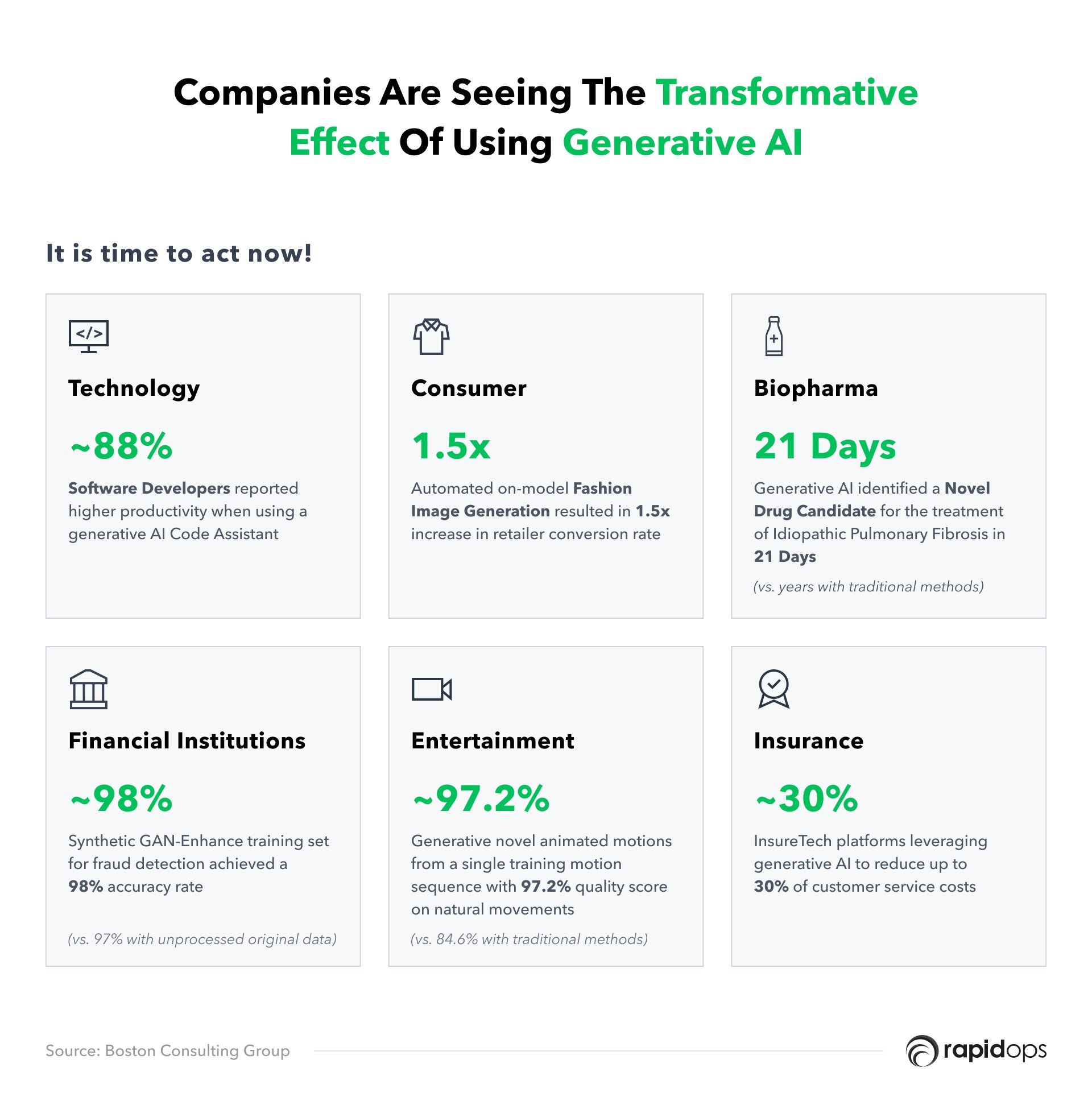
As artificial intelligence (AI) technologies continue to advance, their impact on businesses across all sectors is becoming increasingly significant. AI enables organizations to analyze vast amounts of complex data efficiently, unveiling crucial insights that inform decision-making processes in sales, marketing, finance, and human resources.
By leveraging AI, businesses can predict market trends, uncover hidden opportunities, and adapt proactively to challenges.
AI's potential also extends to fostering innovation and streamlining operations, allowing companies to focus on strategic initiatives that drive growth and long-term success.
With AI's expanding influence in the business world, it is time for organizations to harness its power and maintain a competitive edge.
Overview of Generative AI
Generative AI is a subfield of artificial intelligence that focuses on creating new content, data, or information based on existing data. It involves algorithms and models capable of generating outputs that resemble real-world examples, often by learning patterns, structures, or relationships within the input data.
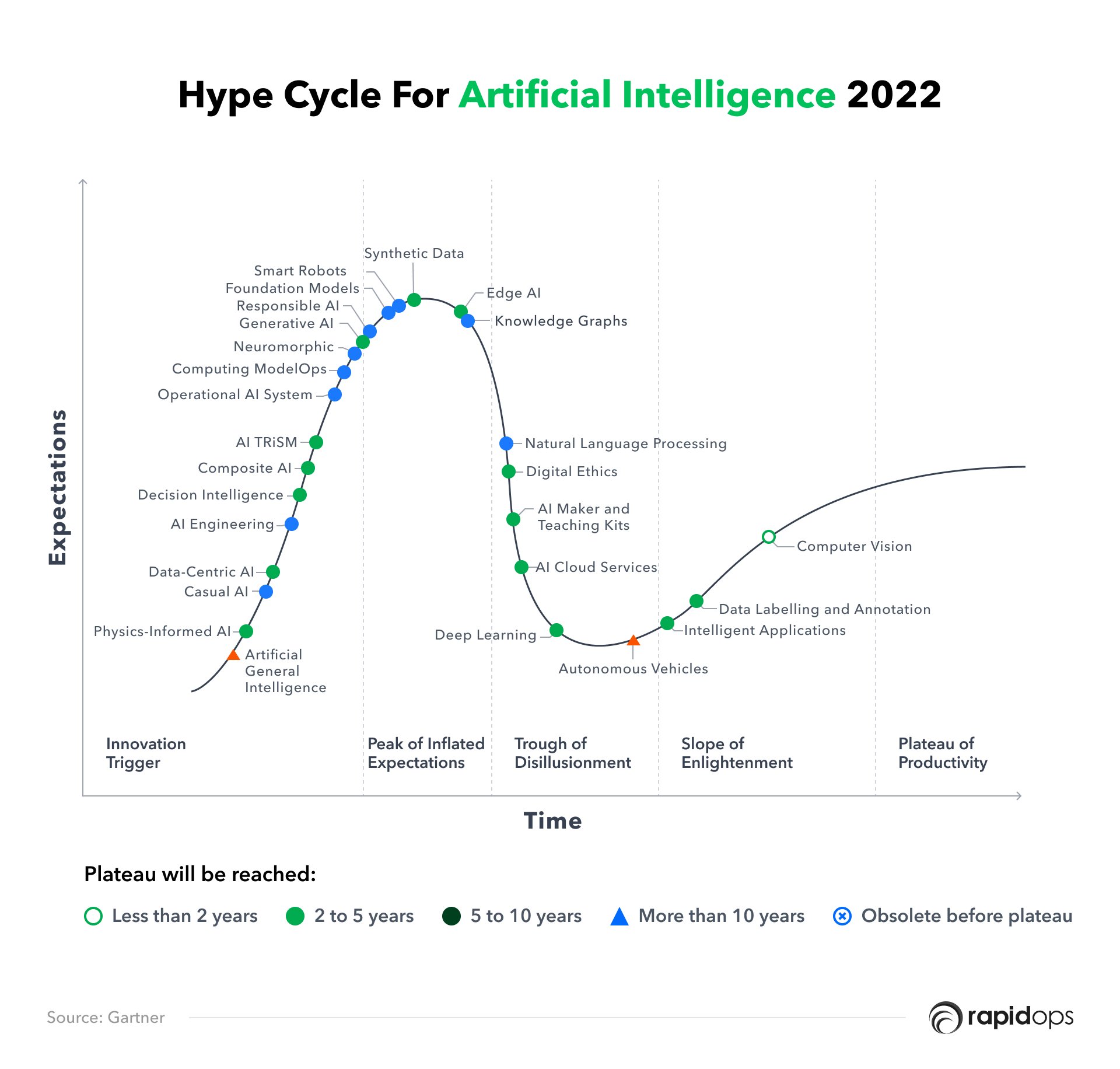
Top reasons businesses should care about Generative AI
Generative AI is making waves in the business world, offering a range of benefits and opportunities for companies across various sectors. Here are the top three reasons why businesses should pay attention to Generative AI:
1. Generating novel data
Generative AI can potentially create entirely new data that did not exist. This ability allows businesses to conduct research, explore innovative solutions, and enhance their testing processes.
2. Enhancing existing algorithms
By producing high-quality training data for neural networks, Generative AI can significantly improve the performance of existing algorithms. This enables the development of advanced deep learning architectures and contributes to the continuous optimization of AI systems.
3. Designing superior machines
At its core, Generative AI is a technology that designs better machines. By harnessing the power of Generative AI, businesses can create more efficient, intelligent, and adaptable systems, driving innovation and staying ahead in the competitive landscape.
But the benefits of Generative AI don't end here. As the technology continues to evolve, businesses can expect to uncover new applications and opportunities to capitalize on the power of Generative AI, leading to enhanced performance, growth, and success.
In their 2022 Emerging Technologies and Trends Impact Radar report, Gartner highlighted Generative AI as one of the most transformative and rapidly developing technologies.
Moreover, they've made some striking forecasts regarding its future implications.
It's anticipated that by 2025, Generative AI will be responsible for producing 10% of all data, a considerable leap from its current contribution of less than 1%.
Additionally, it's projected to create 20% of all test data for consumer-facing applications. It will be employed in half of all drug discovery and development initiatives by 2025.
By 2027, 30% of manufacturers will utilize Generative AI to enhance their product development processes.
Key Generative AI technologies
There are several key technologies and approaches within Generative AI:
1. Generative Adversarial Networks (GANs)
GANs consist of two neural networks – a generator and a discriminator – that work together in a competitive process. The generator creates synthetic data samples, while the discriminator evaluates their quality by comparing them to real samples. The generator continually refines its output to create more convincing data, producing highly realistic results.
2. Variational Autoencoders (VAEs)
VAEs are an unsupervised learning model that can generate new data by learning a compressed input data representation. They consist of two neural networks, an encoder and a decoder, which learn to reconstruct the input data while capturing the underlying structure and patterns.
3. Transformer-based language models (e.g., GPT series)
These models, like OpenAI's GPT, are designed for natural language processing tasks and can generate highly coherent and contextually relevant text by learning from vast amounts of textual data. They utilize the transformer architecture to capture long-range dependencies and relationships within the input data.
Want to keep up with the latest
AI advancements? Check out our up-to-date AI Tracker.
Explore NowApplications of generative AI in business
As Generative AI technologies, such as large language models (LLMs) like ChatGPT, continue to evolve and advance, their impact on businesses across industries grows exponentially. With the capacity to generate original content, including text, music, and images, like the AI Image Generator, Generative AI has the potential to transform industries and redefine how we live and work.
A pressing question on the minds of today's business leaders is:
"How can I harness the power of Generative AI for my business?"
Organizations can unlock new opportunities, drive innovation, and enhance efficiency by leveraging Generative AI. Some potential applications include:
1. Personalized marketing and advertising campaigns
Generative AI is revolutionizing marketing and advertising by enabling businesses to create highly personalized content for customers. By analyzing consumer data and preferences, AI-driven algorithms can generate tailored marketing messages and campaigns, significantly boosting engagement and conversions.
With tools such as AI Logo Maker, companies can design unique logos that resonate with their target audience, enhancing their brand identity.
2. Innovating product and service design
Generative AI empowers businesses to improve their product and service offerings through data-driven insights, content, and design automation, such as logo designs. By exploring numerous design possibilities, AI can suggest innovative solutions, optimize existing designs, and create more appealing and functional products and services.
3. Optimizing supply chain and logistics
With the ability to analyze vast amounts of data and predict future trends, Generative AI can streamline supply chain and logistics processes. AI-driven systems can optimize inventory management, identify bottlenecks, and recommend more efficient routes, ultimately reducing costs and improving customer satisfaction.
Check our infographic to know how AI is revolutionizing the supply chain industry!
Download Now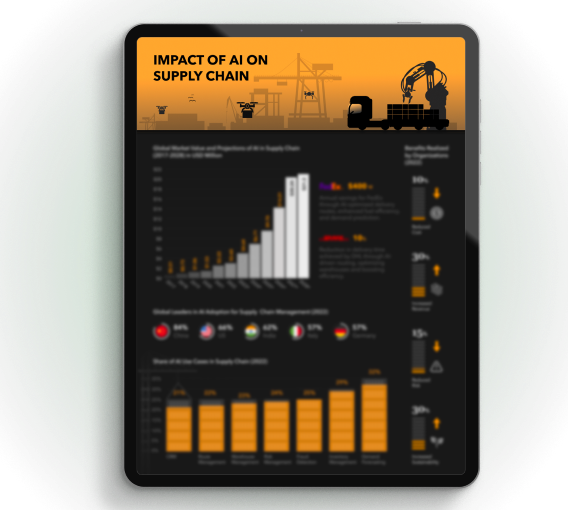
4. Automating content generation and curation
Generative AI's natural language processing capabilities enable businesses to automate content generation and curation. From writing engaging articles to generating personalized recommendations, AI can create diverse and high-quality content, freeing up valuable resources and time for other strategic activities.
Whether inbound or outbound, marketing plays a vital role in a business's success. It encompasses advertising, messaging, positioning, brand storytelling, and fostering meaningful connections with potential customers.
The key to effective marketing lies in the content, but traditional content creation methods can be time-consuming and often rely on trial and error.
Generative AI offers a transformative solution for marketers, enabling them to generate content swiftly and effortlessly while focusing on creative concepts. Tools like Jasper AI and Writer AI produce marketing copy and visuals, while Beautiful.ai's DesignerBot automates the creation of presentations.
Runway ML offers AI-powered video, and Mutiny utilizes AI to optimize website conversion rates. These innovative resources empower marketers to iterate on concepts efficiently, refining content to achieve optimal results.
5. Encouraging creative problem-solving and innovation
Generative AI's ability to analyze data, identify patterns, and generate novel solutions fosters creative problem-solving and innovation within organizations. By providing fresh perspectives and insights, AI can help businesses identify new opportunities, tackle complex challenges, and drive growth.
6. Advancing drug discovery and healthcare solutions
In the healthcare sector, Generative AI assists in drug discovery and developing personalized patient treatments. By analyzing massive amounts of patient data and clinical trial results, AI can identify promising drug candidates, predict treatment efficacy, and optimize dosing regimens, ultimately accelerating the development of life-saving therapies.
Real-world Generative AI implementation
Generative AI holds remarkable potential in exploring an array of possible designs for an object to pinpoint the optimal or most fitting solution. It enhances and expedites design processes across numerous fields and can "invent" innovative designs or objects potentially overlooked by human insight.
The realms of marketing and media are already experiencing the transformative effects of Generative AI, and the trend is projected to surge in the coming years. According to forecasts by Gartner:
By 2025, a substantial 30% of outbound marketing communications from large-scale organizations will be synthetically generated, a marked increase from less than 2% in 2022.
By the year 2030, it is expected that a major blockbuster film will be released with a staggering 90% of its content generated by AI, from text to video, a phenomenon virtually unheard of in 2022.
Considering this, AI innovations are accelerating, paving the way for numerous use cases for Generative AI across many industries, including the following five.
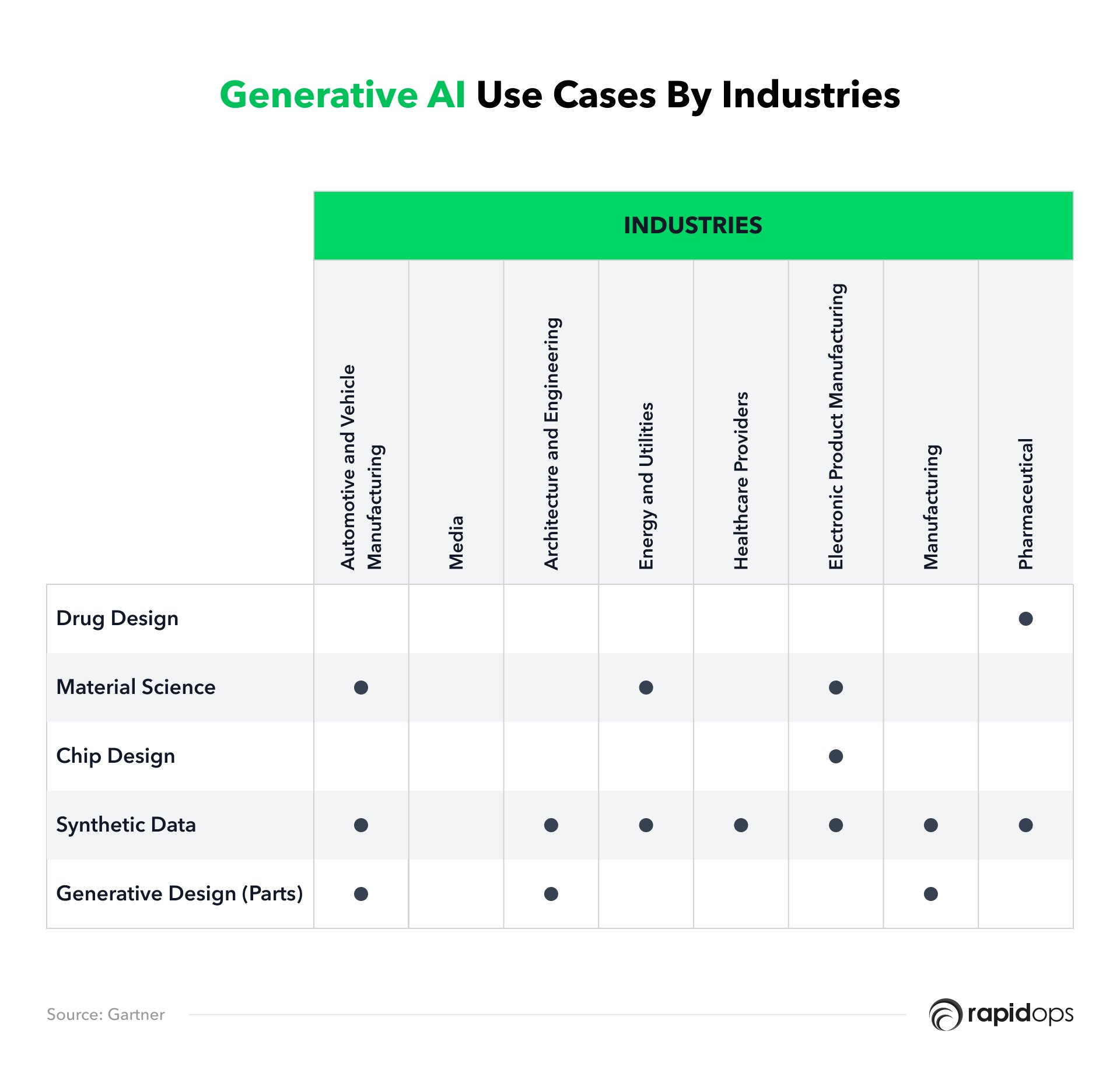
1. Streamlining drug design with Generative AI
Generative AI has already proven its utility in designing drugs for diverse applications within months, presenting pharmaceutical companies with significant potential to curtail both costs and timelines associated with drug discovery. Let's look at some crucial disruptions that generative AI has brought to the medical industry.
a. Increased speed of drug discovery
Generative AI can significantly shorten the drug discovery timeline, which traditionally can take up to 10 years or more. For instance, Insilico Medicine published a study in 2020 stating that they successfully designed, synthesized, and validated a novel drug candidate in just 46 days using AI technology.
b. Cost efficiency
The traditional drug discovery process is expensive, often costing billions of dollars. By using AI to identify promising candidates early in the process, these costs can be drastically reduced.
c. Drug repurposing
AI has been utilized to find new uses for existing drugs, a process known as drug repurposing. For example, in the wake of the COVID-19 pandemic, BenevolentAI used its AI platform to identify Baricitinib, a rheumatoid arthritis drug, as a potential treatment for COVID-19.
d. Predicting drug interactions and side effects
Generative AI models can predict potential drug-drug interactions and side effects based on other drugs' structure and known effects, helping to increase safety and efficacy.
e. Personalized medicine
Generative AI holds great potential in personalized medicine. By analyzing a person's unique genetic makeup, AI can help design drugs tailored to individual patients.
2. Material science revolutionized by Generative AI
Automotive, aerospace, defense, medical, electronics, and energy sectors are experiencing the transformative impact of Generative AI in creating entirely novel materials with targeted physical properties.
An approach known as the inverse design is leveraged, which outlines the required properties and identifies materials likely to possess those attributes.
This method replaces the traditional reliance on the chance discovery of suitable materials, leading to identifying substances with superior conductivity or magnetic attraction for use in the energy and transportation sectors or materials with enhanced resistance to corrosion.
3. Generative AI's role in chip design
Generative AI employs reinforcement learning, a machine learning technique, to optimize component placement in semiconductor chip design or floor planning. This application significantly shortens the product-development life cycle, trimming it from weeks with human experts to mere hours with Generative AI.
4. Synthetic data generation through Generative AI
Generative AI plays a vital role in creating synthetic data – a category of data generated synthetically instead of being directly observed in the real world. This process ensures the privacy of the original sources used for model training.
For instance, healthcare data can be artificially generated for research and analysis, preserving the privacy of patients whose medical records were used.
5. Generative design of components
Generative AI empowers manufacturing, automotive, aerospace, and defense industries by optimizing parts to meet specific goals and constraints, like performance parameters, material types, and manufacturing methods.
As an example, automotive manufacturers can leverage Generative design to create lighter components, thereby contributing to their objective of enhancing fuel efficiency in vehicles.
Navigating challenges and considerations in Generative AI implementation
While Generative AI presents numerous business opportunities, some challenges and considerations must be addressed to ensure its successful implementation.
1. Data quality and availability
High-quality data is crucial for training AI models effectively. Inadequate or consistent data can lead to accurate or biased outcomes. Businesses must ensure they can access sufficient and reliable data sources to train their Generative AI models, fostering accurate and actionable insights.
2. Computational resources and costs
Developing and deploying Generative AI models can be resource-intensive, requiring powerful hardware and robust infrastructure. Businesses must evaluate the costs associated with these computational resources and consider whether investing in on-premises hardware, cloud-based solutions, or partnering with specialized providers best fits their needs.
3. Ethical concerns and potential biases
Generative AI models may perpetuate or amplify existing biases in the data they are trained on. Businesses must prioritize transparency, fairness, and accountability in AI implementation to address this issue.
By actively monitoring and mitigating biases, businesses can ensure their AI models align with ethical standards and contribute positively to society.
4. Intellectual property and copyright issues
As Generative AI creates original content, intellectual property and copyright ownership questions arise. Businesses need to navigate these complex legal landscapes to protect their creations and avoid potential infringements.
By staying informed about evolving regulations and collaborating with legal professionals, businesses can mitigate risks and establish a solid foundation for leveraging Generative AI.
Preparing your business for Generative AI adoption
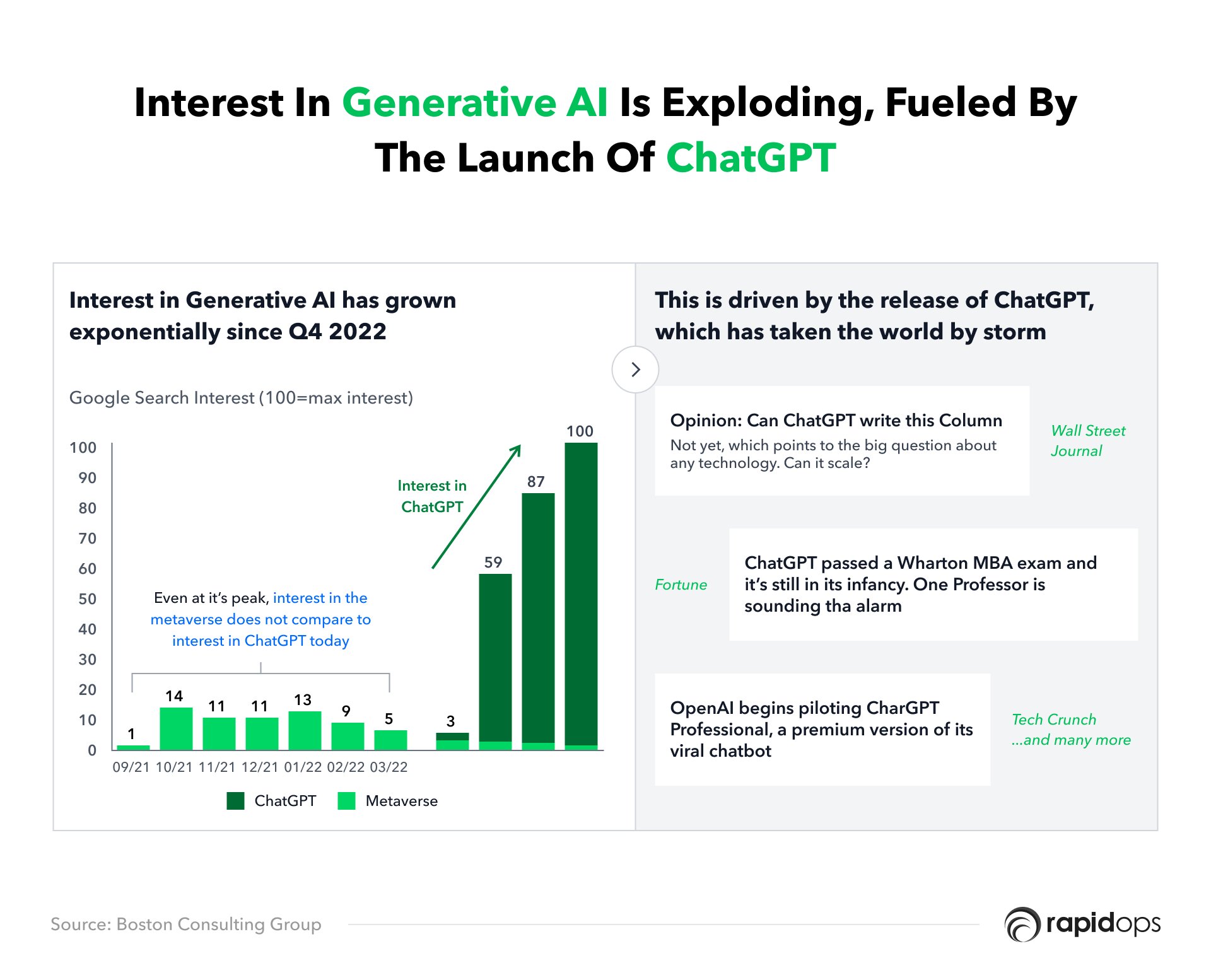
Generative AI solutions such as OpenAI's ChatGPT are primed to revolutionize how businesses function and interact with their clientele. However, identifying the starting point can appear intimidating. Hopefully, this custom Generative AI roadmap can assist you in pinpointing the real opportunities that Generative AI can harness within your business.
Construct your roadmap in a concise span of just four weeks
1. Inform and Innovate (Half-day workshop)
- Gain a comprehensive understanding of what Generative AI signifies for your industry and business.
- Upskill your executive team and develop a comprehensive list
- Ensure your executive team is abreast of the latest developments in Generative AI, including demonstrations of cutting-edge advancements in the field.
2. Rank and Define (2-3 weeks)
- Identify high-value opportunities offering a significant first-mover advantage
- Develop a prioritized Generative AI roadmap and business case
- Rank Generative AI use cases based on their technical feasibility, commercial prospects, and your team's preparedness.
3. Strategize for Deployment (1 week)
- Comprehend how to deploy this technology to robustly and safely deliver value
- Formulate a deployment plan for high-priority use cases
- Devise an actionable execution plan to construct and deploy your most feasible, high-priority Generative AI use cases.
Investing in the right technology stack for Generative AI implementation
A technology stack, often called a tech stack, encompasses the assembly of technologies, platforms, and tools employed in the construction and deployment of software applications. In the creation of effective Generative AI systems, a well-rounded tech stack is of paramount importance. This stack incorporates various components such as machine learning platforms, programming languages, cloud infrastructure, and data processing instruments. Let's delve into these fundamental elements and their significance in a Generative AI tech stack:
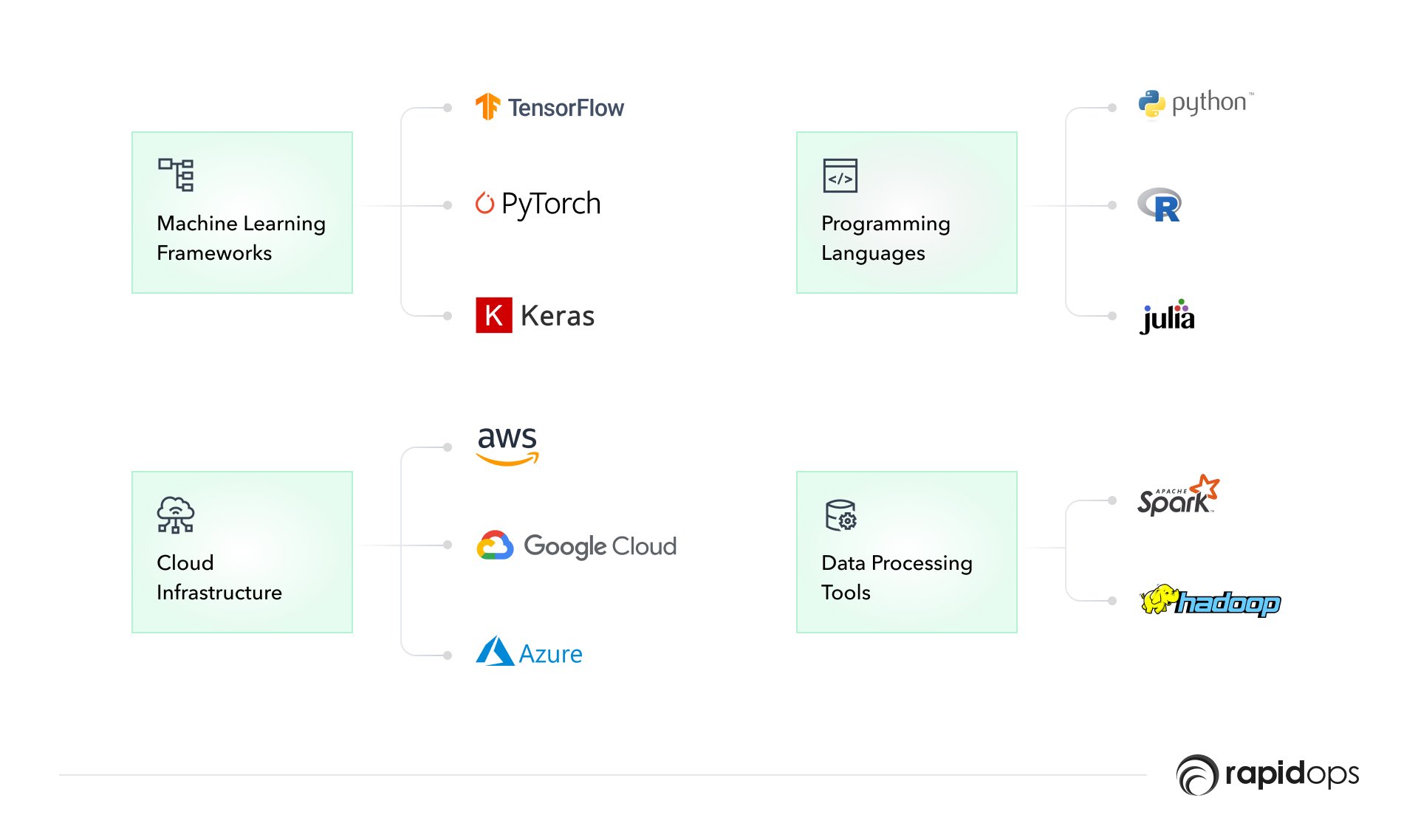
1. ML (machine learning) frameworks
Generative AI systems hinge on intricate machine learning models to fabricate new data. Frameworks like TensorFlow, PyTorch, and Keras offer tools and APIs that facilitate model building and training.
They also encompass various pre-built models for image, text, and music generation, making these frameworks and APIs an integral part of the Generative AI tech stack.
Furthermore, these platforms offer flexibility in designing and personalizing the models to achieve the desired precision and quality.
2. Programming languages
The selection of programming languages is crucial in developing Generative AI systems that balance user-friendliness and the performance of Generative AI models.
Due to its simplicity, readability, and comprehensive library support, Python is the predominant language in machine learning and is preferred for Generative AI systems. However, other languages like R and Julia are also used in certain scenarios.
3. Cloud infrastructure
Incorporating cloud infrastructures into a Generative AI tech stack is essential, given the extensive computing power and storage capacity required to train and execute models.
Cloud service providers like Amazon Web Services (AWS), Google Cloud Platform (GCP), and Microsoft Azure offer scalability and flexibility, which are crucial for deploying Generative AI systems.
These services include virtual machines, storage, and machine learning platforms.
4. Data processing tools
Data plays a pivotal role in constructing Generative AI systems. Before it can be utilized to train models, data must undergo preprocessing, cleaning, and transformation.
A Generative AI tech stack commonly includes tools like Apache Spark and Apache Hadoop to manage large datasets efficiently. These tools also offer data visualization and exploration capabilities, assisting in data understanding and pattern identification.
Conclusion: Generative AI has great transformative potential
Generative AI is evolving at record speed. And CEOs are still trying to learn the technology's business value addition and associated risks.
We will conclude this article by acknowledging that Generative AI stands at the forefront of a technological revolution. Since the release of novel content-creating tools such as ChatGPT, Bard, Claude, and Midjourney, CEOs understandably wonder if this is just another tech hype or an industry-changing opportunity. And if it is the latter, will it add value to my business?
This technology has the potential to reshape entire industries and redefine business operations. Its capacity to generate innovative and custom content, design products, and even drive research in fields such as drug discovery is unparalleled.
Businesses that leverage this technology will lead the market as early adopters. However, as with any disruptive technology, the adoption journey will be challenging, requiring thoughtful strategic planning, investment, and a thorough understanding of the technology's capabilities and limitations.
As we continue to explore the potential of Generative AI, its transformative impact will reshape the business landscape in ways we can only begin to imagine.
You must have a concrete plan to create a strong foothold in your industry. And because the planning needs to be effective and ROI-oriented, we suggest you get on a discovery call with our AI experts to understand the true potential of Generative AI implementation in your business.

Saptarshi Das
Content Editor
9+ years of expertise in content marketing, SEO, and SERP research. Creates informative, engaging content to achieve marketing goals. Empathetic approach and deep understanding of target audience needs. Expert in SEO optimization for maximum visibility. Your ideal content marketing strategist.
What’s Inside
- The growing impact of AI on businesses
- Overview of Generative AI
- Applications of generative AI in business
- Real-world Generative AI implementation
- Navigating challenges and considerations in Generative AI implementation
- Preparing your business for Generative AI adoption
- Investing in the right technology stack for Generative AI implementation
- Conclusion: Generative AI has great transformative potential

Let’s build the next big thing!
Share your ideas and vision with us to explore your digital opportunities
Similar Stories
- AI
- 4 Mins
- September 2022

- AI
- 9 Mins
- January 2023


Receive articles like this in your mailbox
Sign up to get weekly insights & inspiration in your inbox.

